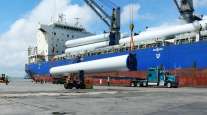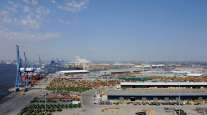Senior Reporter
Ports Set Volume Records as Shippers Rush to Have Goods Processed Before Tariffs Bite

Some of the nation’s largest ports keep setting new records for cargo volumes, as trade tensions between the United States and some of its trading partners propel a rise in container traffic.
The Port of Los Angeles — the nation’s busiest port — reported the busiest July in its 111-year history, processing 833,568 20-foot-equivalent units, or TEUs, a 4.6% increase from the 796,804 TEUs it moved in July 2017.
“With a robust economy and cargo owners moving goods ahead of expected tariffs, our terminal operators, labor force and supply chain partners seamlessly moved a record amount of cargo across our docks,” said Gene Seroka, the Port of L.A.’s executive director.
The South Carolina Ports Authority said August was its busiest month ever, as it moved 206,541 TEUs, a 16% increase from year-ago volume of 177,728 TEUs. Last month’s result surpassed the port’s previous all-time record — achieved in June — of volume of 201,163 TEUs.
“SCPA has experienced incredibly strong growth in 2018, with August marking the single best month in our history as well as the six consecutive record-setting month for container volumes,” CEO Jim Newsome said. “Fall is typically a seasonally strong time for our port, and while we look forward to continued growth through 2018, we will continue to monitor the potential for tariff negotiations to adversely impact containerized trade if prolonged or not otherwise resolved successfully.”

Trucks with Maersk shipping containers enter the Port of L.A. (Patrick Fallon/Bloomberg News)
One year after the Port Authority of New York and New Jersey completed increasing the height of the Bayonne Bridge — thus permitting larger ships to call on the port — the facility reported July TEU volume rose 7.9% to 622,559 TEUs, compared with 576,947 in July 2017.
The $1.6 billion project raised the bridge height from 151 feet to 215 feet, allowing the port to service ships up to 18,000 TEUs. Previously, the maximum vessel size was 9,800.
Last month, the Port of Virginia had its second most productive month ever, processing 258,821 TEUs, an increase of nearly 8% compared with a year ago. “We are seeing some inbound cargo that is moving in anticipation of expanded tariffs on select imports,” CEO John Reinhart said.
All of this growth is likely compelled by fears among shippers that their costs could soon rise thanks to forthcoming tariffs, experts said.
“For a number of shippers they can see what’s coming in terms of the trade situation and they’re trying to beat the tariff timing, to get the goods to move before the tariffs are in place,” Hackett Associates Economist Paul Bingham said in an interview with Transport Topics. “On a risk-adjusted basis, it’s still much cheaper to pay a couple of months of inventory carrying costs than 10% or 25% tariffs on these commodities.”
Bingham added, “There’s a lot of concern that these very high growth rates and the volumes we have been seeing on a monthly frequency are driven by attempts to build inventory to get ahead of the tariff situation. There is a payback coming and it’s going to be sharp once even more tariffs are in place, in terms of a falloff in volume, even if the economy remains strong.”

Containers are unloaded at the Port of Virginia in Norfolk. Last month, the port had its second most productive month ever, processing 258,821 TEUs, an increase of nearly 8% compared with a year ago. (Port of Virginia)
President Donald Trump has already imposed $200 billion in tariffs on Chinese goods and on Sept. 7 said he is prepared to add more. “I hate to do this, but behind that there is another $267 billion ready to go on short notice if I want,” Trump said.
Research by the American Association of Port Authorities shows the trade sanctions will impact 9% of the total volume of products imported and exported to the United States. Trade with China accounts for 16% of items moved in and out of California ports, 13% in Georgia and 12% in Washington state.
Of the major ports reporting cargo volume, only the Port of Long Beach reported a decline, with its August numbers falling 1.9% compared with last year. However, August 2017 was one of the busiest months in the port’s 107 years of operation. Also, the port said cargo volume through the first eight months of 2018 is 9.4% higher than in 2017, which was a record-setting year.
“Our port’s decline in cargo over the last two months is in large part due to a realignment of ocean carrier alliance services and port calls,” said Mario Cordero, the port’s executive director. “Another factor is higher tariffs by the United States and China. Thus far, that appears to have helped increase traffic, as shippers act to beat duties imposed on goods this summer.”




